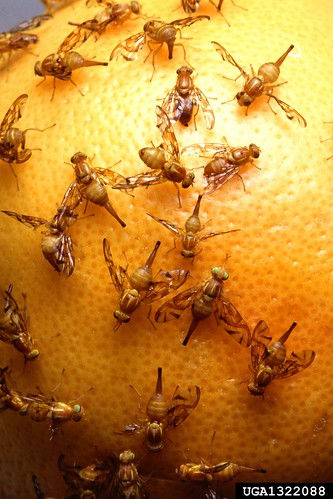
USDA has proclaimed April to be Invasive Plant Pest and Disease Awareness Month, so this is the perfect time to consider how invasive species can crawl, swarm or ooze their way into your daily life. The fact is, invasive pests and diseases hunger for many of the same things we enjoy each day. And as they feast on America's agricultural and natural resources, they can devastate crops and forests, throw ecosystems out of balance and lead to lost jobs and closed export markets.
So let's follow a day in your life with these invasive species, starting right at the breakfast table. You savor your glass of orange juice at breakfast. Citrus greening disease also loves America’s citrus trees ... to death, costing Florida’s citrus industry billions of dollars and thousands of jobs. You pour maple syrup over your pancakes. If Asian longhorned beetles had their way, they’d be enjoying those maples, too ... as they eat them from the inside out. This tree killer, now in Massachusetts, New York, and Ohio, threatens forest resources valued at billions of dollars.
After breakfast, you might relish spending time in the garden or backyard. The giant African snail won’t want to leave your landscape because it can munch on 500 different types of plants. This slimy pest, which can carry a parasite that can cause meningitis in people, was detected in Florida in 2011. USDA and the state are actively eradicating it and have collected and destroyed more than 115,000 snails.
Invasive pests and diseases prefer many of your lunchtime favorites. Exotic fruit fly maggots can’t resist apples, pears, and dozens of other fruits and vegetables. In Florida, Texas, and California, USDA and its partners have eradicated numerous exotic fruit fly outbreaks over the last several decades before they could wreak havoc on crops.
The afternoon is a great time for a baseball game. But the sound of an ash bat smacking a ball into the stands could be silenced. The emerald ash borer beetle, detected in 18 states, has destroyed tens of millions of ash trees so far.
At dinner, you might like to relax with a fine domestic wine. Another grape connoisseur is the European grapevine moth. This little pest, almost eradicated in California, could threaten $8.7 billion in U.S. fruit crops.
So it’s plain to see why USDA has dedicated April as Invasive Plant Pest and Disease Awareness Month. We don’t want these destructive invasive species to shadow you as you go about your daily life. We developed “Seven Ways to Leave Hungry Pests Behind” to empower you to protect the things you treasure: America’s agricultural bounty and natural beauty. Take a moment learn these seven ways by visiting our Hungry Pests website, or watch the video below!
USDA’s Animal and Plant Health Inspection Service (APHIS) has declared April as Invasive Plant Pest and Disease Awareness Month. Throughout the month, APHIS will post a series of blog entries here and also share invasive plant pest and disease information through our twitter feed. APHIS and its federal and state partners are fighting to protect our communities, our public lands, and our agricultural resources from invasive species. But we can’t do it alone. Join the fight by visiting www.HungryPests.com.
